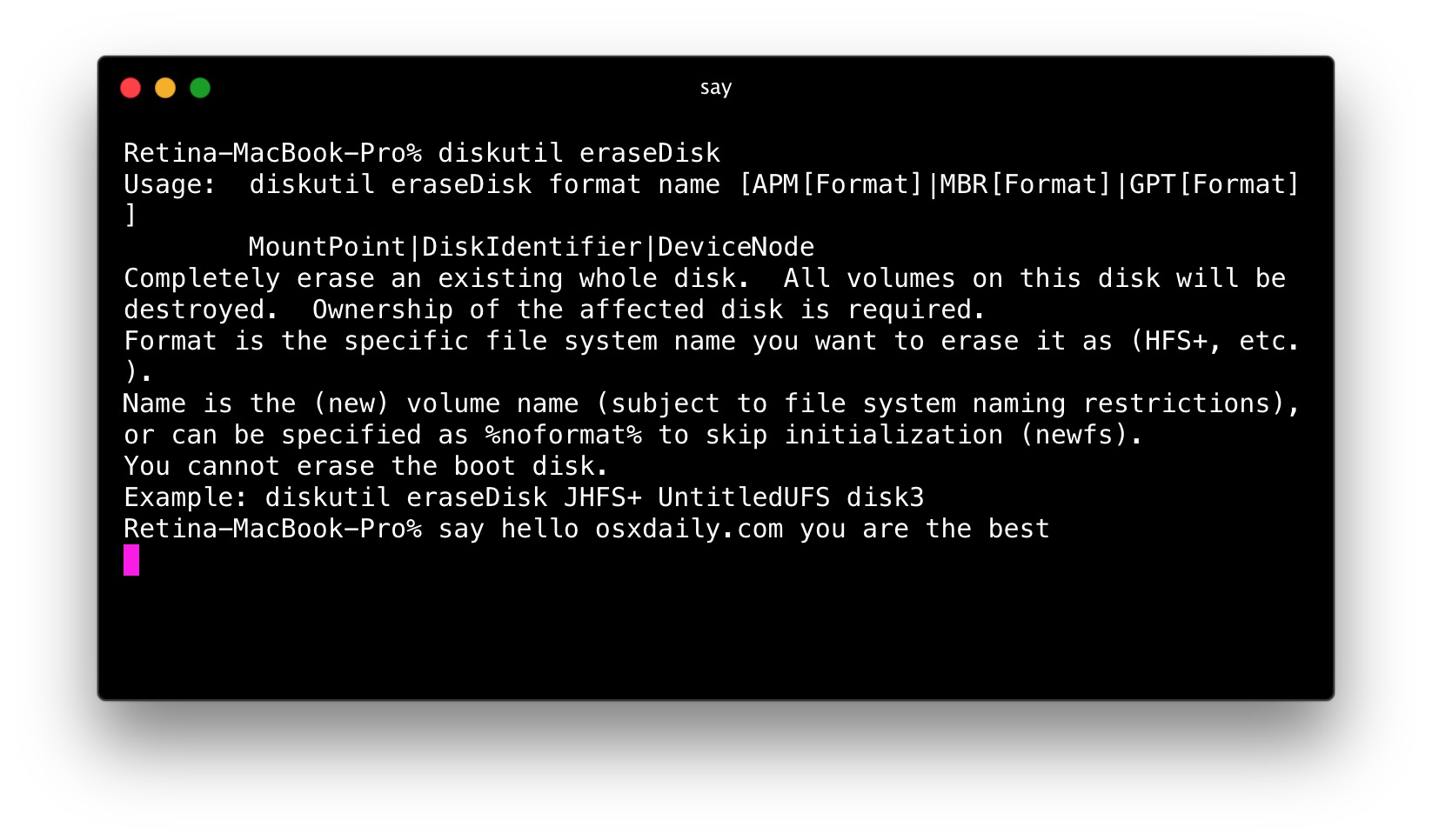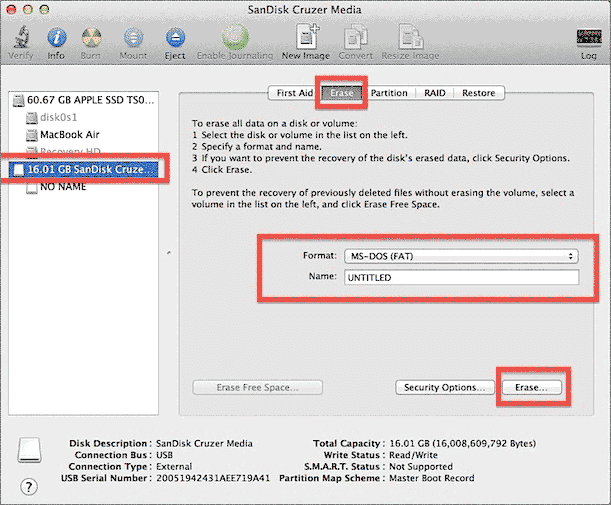However, a USB drive formatted to FAT32 doesn't support an individual file larger than 4GB. ExFAT, the successor of FAT32, offers larger storage space and supports files larger than 4GB. So, if you need to transfer large files between PCs and Macs, ExFAT will be the best format for your USB drive. 3 How to Format a USB Drive on Mac. Step 1 MAC: HOW TO FORMAT A FLASH DRIVE TO FAT32 IN MAC OS X. Connect a Flash Drive to your Mac OSX computer. Open Finder, search for Disk Utility.
For Apple Mac users, there are two ways to format USB flash drive to FAT32, including Disk Utility and Terminal command line. Refer to detailed steps of using both tools for FAT32 format. Formatting would erase data completely, make sure that you have a data backup. Otherwise, you can use data recovery software to recover data from a formatted USB drive.
Are you looking for a secure way to format USB to FAT32 on Mac? You are at the right place. Follow here, you can find two methods that will assist you in doing so on your storage device. And if you lost data during the formatting, reliable Mac file recovery software is ready to help anytime:
| Workable Solutions | Step-by-step Troubleshooting |
|---|---|
| Method 1. Use Disk Utility | Connect USB to Mac > Go to Applications > Utilities > Disk Utility > Select USB and click 'Erase'...Full steps |
| Method 2. Use Terminal Command | Connect USB to Mac > Hit cmd + space keys > Type terminal and hit Enter...Full steps |
| Bonus Tip. Recover Formatted Data | If you lost data due to formatting, run EaseUS file recovery software > Scan and recover formatted data...Full steps |
How to Format a USB Flash Drive with Mac to FAT32
Computer users who use a USB might have the demand for formatting it to the FAT32 file system. Compare with the other commonly used NTFS file system on a flash drive, FAT32 has a compatibility advantage across many operating systems.
It's a universal format that is compatible with Mac OS X/macOS, Windows, Linux, and DOS systems. So, if users anticipate using the flash drive with more than one operating system, they will definitely benefit from the FAT32 file system. For Apple Mac users, there are two ways to format a USB flash drive to FAT32, namely Disk Utility and Terminal command line. Below are the detailed steps of the FAT32 format with both methods.
Method 1. Format FAT32 on Mac [Disk Utility]
To format USB to FAT32 with Disk Utility will erase all data on the flash drive, so before you doing so, please do remember to check whether you have saved useful data to another secure device in advance.
To format the USB drive to FAT32, follow the next steps:
Step 1. Connect the USB flash drive to your Mac computer.
Step 2. Go to Applications >Utilities > Double click and open Disk Utility.
Step 3. Select your USB flash drive on the sidebar, choose Erase.
Step 4. Rename the USB flash drive (optional).
Step 5. Choose the format as MS-DOS (FAT) for Format, Master Boot Record for Scheme. Then click Erase.
Wait for the process to complete, then you'll get an empty new USB flash drive with FAT32 as the file system. You can use it for saving data again.
Method 2. Format FAT32 on Mac [Terminal Command Line]
The command-line behavior does the same way to erase data with the Disk Utility. Again, create a backup before taking this action.
To format FAT32 on Mac with Terminal, follow the next steps:
Step 1. Connect the USB flash drive to your Mac computer.
Step 2. Hit cmd + space to run Spotlight, type: terminal, and hit Enter.
Step 3. Type: diskutil list and find out which disk is your USB drive.
Step 4. Type: sudo diskutil eraseDisk FAT32 MBRFormat /dev/disk2.
- sudo gives you user right.
- Diskutil calls disk utility program.
- eraseDisk commands to format.
- FAT32 sets the file system.
- MBRFormat tells disk utility to format with a Master Boot Record.
- /dev/disk2 is the location of the USB drive.

Wait for the process to complete. After this, you can type 'diskutil list' in the command again to check if the formatting has been successful.
Bonus Tip: How to Recover Data from Formatted USB
Formatting the USB would erase the data on it completely, so please make sure that you have a backup. If you don't, you can count on data recovery software to retrieve the lost data.
EaseUS Data Recovery Wizard has both Windows and Mac versions, so it's a good choice for data recovery, no matter you're using a PC or Mac. For Mac users, it only takes a few clicks for the software to scan and display the formatted data. To guarantee an effective data recovery without spending money to no avail, you can install the Mac data recovery free version for the first trial. You can preview all the found data before the final recovery.
To recover data from a formatted USB flash drive on Mac, follow the next steps:
Step 1. Correctly connect your USB flash drive to your Mac. Launch EaseUS Data Recovery Wizard for Mac. Start selecting the flash drive and click 'Scan' to let the software search lost files on it.
Step 2. After a quick scan and deep scan, all files will be presented in the left panel in the scan results.
Step 3. Select files you want to recover and click the 'Recover Now' button. Don't save the recoverable files to the USB drive itself in case of data overwriting.
Dec 16, 2020 • Filed to: Solve Mac Problems • Proven solutions
If your USB flash drive is not recognized by your Apple Mac computer because it has a different format it is kind of difficult to format it. You may not know how to format your USB flash drive to make it compatible with your Mac system but we do and will show you how to do it in this article.

Overview of Formatting USB Drive on Mac
Mac Systems have a different OS to Windows and this is where most of the problems like. Most USB flash drives on sale are designed to work with Windows operating systems that run on Fat32. Mac devices on the other hand run on either Mac OS Extended or APFS. If your drive is an APFS format or a Mac OS format you can format your drive easily but if it is a FAT32 format this may be a problem. If you have made the mistake of buying a flash drive they run on a FAT32 file format you don't have to discard it altogether. There are ways to format a flash drive that runs in a different format and we will show you steps to take to remedy the situation.
Step to Format a USB Drive to FAT32 on Your Mac
- Plug the drive into the Mac system
- Choose Applications- Utilities then Disk Utility
How To Format Usb Drive To Fat32
- From the sidebar pick USB drive
- From the toolbar select Erase
- Name the formatted disk and choose either ExFat or MS-DOS(FAT32) from the menu
Format Flash Drive Mac Fat32 Terminals
- Select erase to format your drive depending on the selection you have picked (FAT32 or ExFAT)
Convert/Format USB Flash drive to FAT32 using Command Line
- Connect Flash drive to Mac
- Tap CMD and space bar to open Spotlight. Type 'terminal' and press Enter
- Type in :diskutill land locate your USB drive
- Type in sudo.diskutilerasediskFAT32MBRFormat/Dev/disk2
- Sudo will give you the user right
- Diskutill will call in the utility program
- Erasedisk commands will format
- FAT32 will set the file system
- MBRFormat will tell the disk to format with Master Boot
- /Dev/disk2 will be the USB drive location
You will have to wait a while for the format to be completed. Type in : diskutill to check if the process was successful.
If you follow these steps religiously you should be able to resolve the issue quickly. If you're searching for a way that helps you recover formatted USB drive on Mac, download Recoverit Data Recovery software and go to the page telling you how to restore the formatted hard drive.

Video Tutorial on How to Format a USB Flash Drive on Mac
What's Wrong with Mac
- Recover Your Mac
- Fix Your Mac
- Delete Your Mac
- Learn Mac Hacks

Comments are closed.